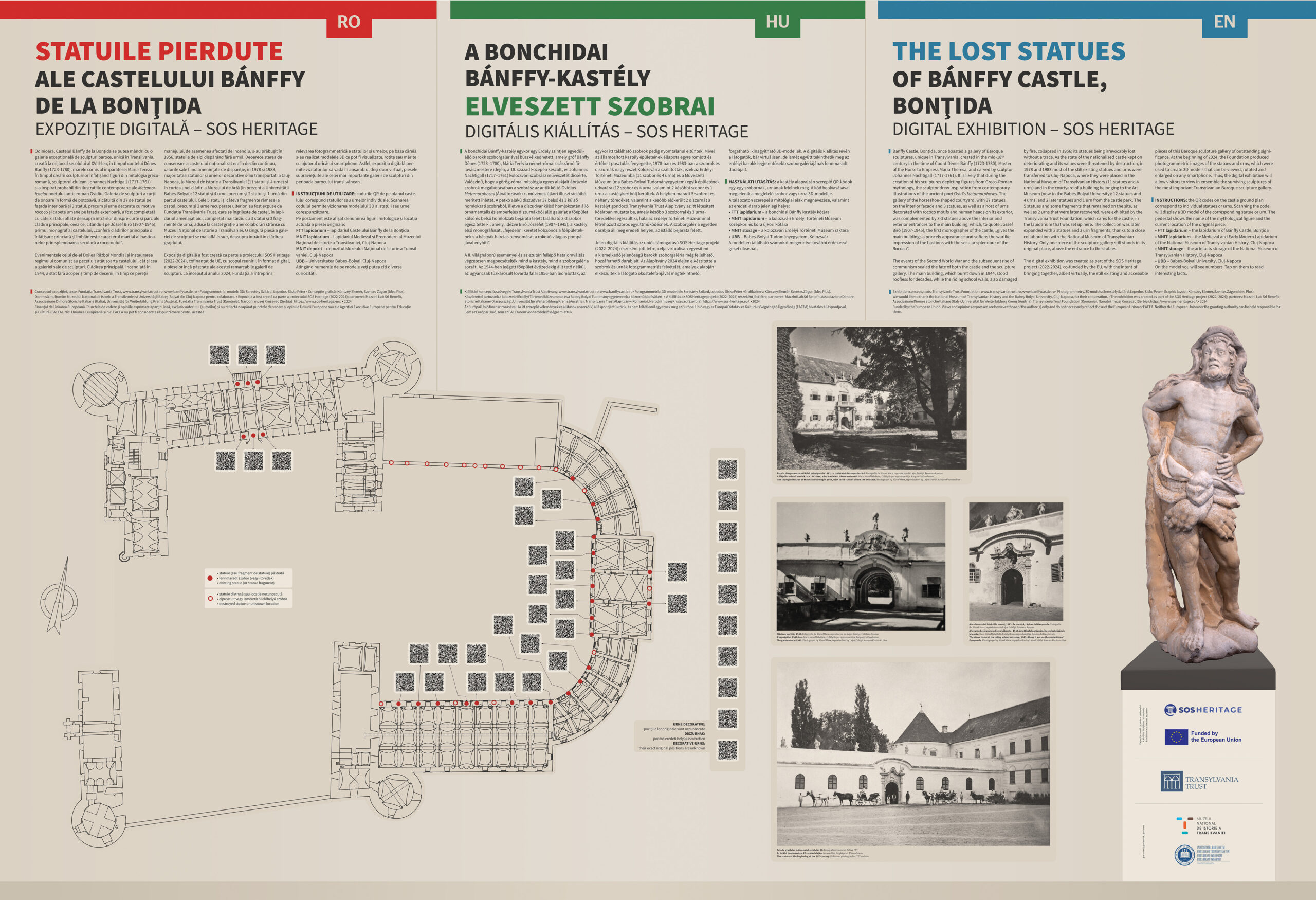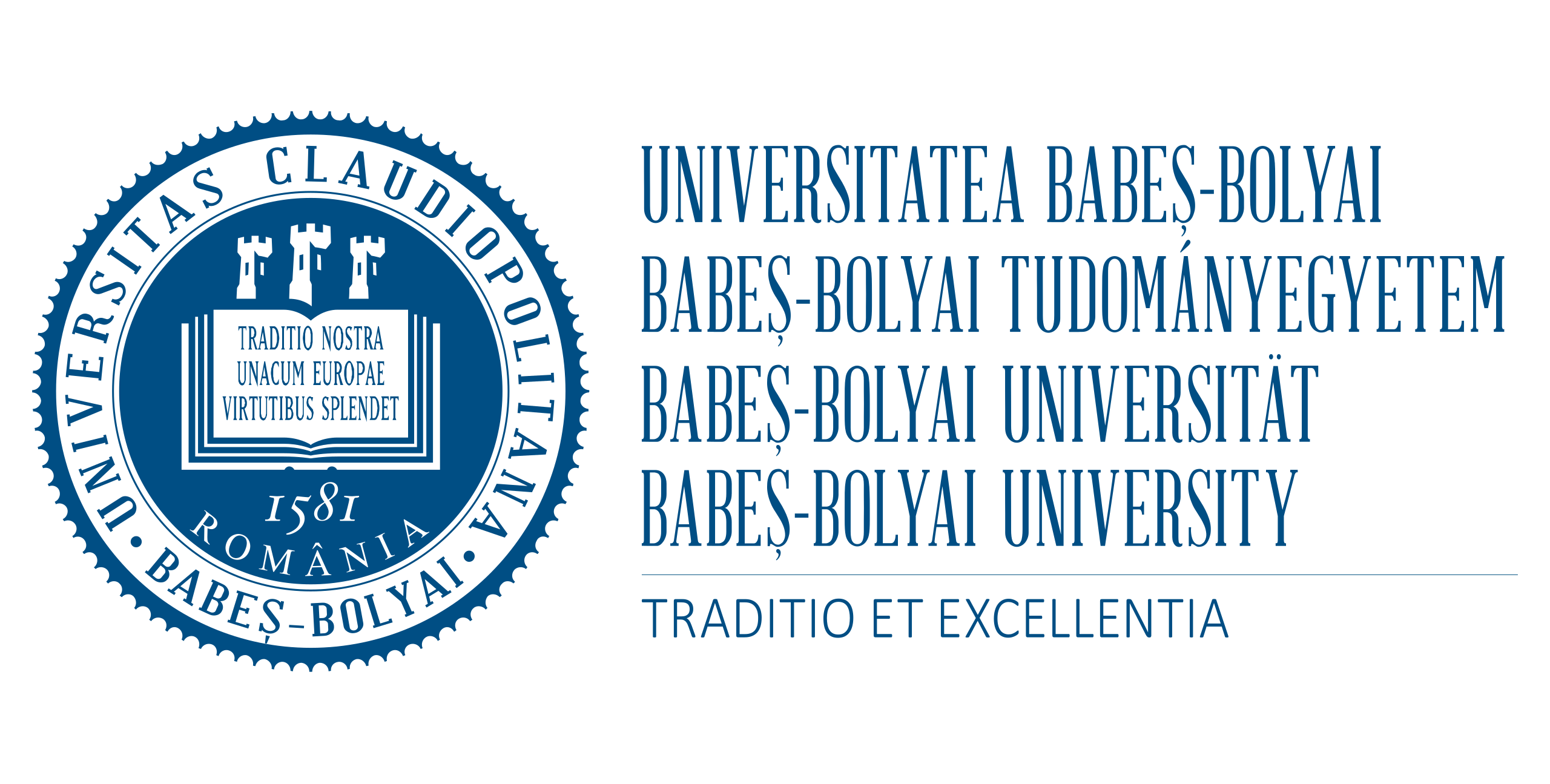The Lost Statues of Bánffy Castle, Bonțida
Digital exhibition by
On 28 April 2024, the digital exhibition entitled “The Lost Statues of Bánffy Castle, Bonțida” was opened in the newly reorganised lapidary set up in the former chapel of Bánffy Castle.
The digital exhibition, which at the castle can be viewed with the help of a smartphone, reading QR codes on a physical panel, was created as part of the SOS Heritage project, co-funded by the European Union, as one of the pilots of SO1: to share and test best practices of digital content creation and communication for successful engagement.
The objective of the pilot was to digitise all surviving pieces of the castle’s Baroque sculpture gallery and presenting them as a digital collection. Currently, these sculptures are found in four different locations: some are at Bánffy Castle, being in fact in the same room as the digital exhibition’s panel, thus creating an opportunity of examining both the physical object and the digital copy, while others ar found in the artefacts storage and in the Medieval and Early Modern Lapidarium of the National Museum of Transylvanian History, Cluj-Napoca, as well as at the Babeș-Bolyai University, Cluj-Napoca. The story of how the statues ended up in so many locations can be read below.
Exhibition panel
The panel shows the castle ground plan, as well as the exact positions of the sculptures (when tehse are known).

Historical context
Bánffy Castle, Bonțida, once boasted a gallery of Baroque sculptures, unique in Transylvania, created in the mid-18th century in the time of Count Dénes Bánffy (1723-1780), Master of the Horse to Empress Maria Theresa, and carved by sculptor Johannes Nachtigall (1717-1761). It is likely that during the creation of his sculptures depicting figures from Greco-Roman mythology, the sculptor drew inspiration from contemporary illustrations of the ancient poet Ovid’s Metamorphoses. The gallery of the horseshoe-shaped courtyard, with 37 statues on the interior façade and 3 statues, as well as a host of urns decorated with rococo motifs and human heads on its exterior, was complemented by 3-3 statues above the interior and exterior entrances to the main building, which, to quote József Biró (1907-1945), the first monographer of the castle, „gives the main buildings a princely appearance and softens the warlike impression of the bastions with the secular splendour of Rococo”.
The events of the Second World War and the subsequent rise of communism sealed the fate of both the castle and the sculpture gallery. The main building, which burnt down in 1944, stood roofless for decades, while the riding school walls, also damaged by fire, collapsed in 1956; its statues being irrevocably lost without a trace. As the state of the nationalised castle kept on deteriorating and its values were threatened by destruction, in 1978 and 1983 most of the still existing statues and urns were transferred to Cluj-Napoca, where they were placed in the National Museum of Transylvanian History and in the courtyard of a building belonging to the Art Museum (now to the Babeș-Bolyai University). The 5 statues and some fragments that remained on the site, as well as 2 urns that were later recovered, were exhibited by the Transylvania Trust Foundation, which cares for the castle, in the lapidarium that was set up here. The collection was later expanded with 3 statues and 3 urn fragments, thanks to a close collaboration with the National Museum of Transylvanian History. Only one piece of the sculpture gallery still stands in its original place, above the entrance to the stables.
Context of the exhibition’s creation
The digital exhibition was created as part of the SOS Heritage project (2022-2024), co-funded by the EU, with the intent of bringing together, albeit virtually, the still existing and accessible sculptures of this Baroque sculpture gallery of outstanding significance. At the beginning of 2024, the Foundation produced photogrammetric images of the statues and urns, which were used to create the 3D models. Thus, the digital exhibition will allow visitors to view in ensemble the surviving pieces of the most important Transylvanian Baroque sculpture gallery.
About the 3D models
Below you can find all the survining sculptures’ 3D models. The pedestals of the models show the name of the featured mythological figure and the current location of the original piece:
- FTT lapidarium – the lapidarium of Bánffy Castle, Bonțida
- MNIT lapidarium – the Medieval and Early Modern Lapidarium of the National Museum of Transylvanian History, Cluj-Napoca
- MNIT storage – the artefacts storage of the National Museum of Transylvanian History, Cluj-Napoca
- UBB – Babeș-Bolyai University, Cluj-Napoca
On the model you will see numbers. Tap/click on them to read some interesting facts about the featured mythological figures.
The statues above the entrance to the main building
northern façade
The statues above the entrance to the main building
southern, courtyard façade
The statues above the inner façade
of the horseshoe-shaped courtyard
From the no longer existing riding school towards the stables
The statues above the outer façade
of the horseshoe-shaped courtyard
at the gatehouse
The decorative urns above the outer façade
of the horseshoe-shaped courtyard
in no particular order, as the original positions of the pieces are unknown
Imprint
Exhibition concept, texts: Transylvania Trust Foundation, www.transylvaniatrust.ro, www.banffycastle.ro
Photogrammetry, 3D-models: Serestély Szilárd, Lepedus-Sisko Péter
Panel graphics: Könczey Elemér, Szentes Zágon (Idea Plus)
We would like to thank the National Museum of Transylvanian History and the Babeș-Bolyai University, Cluj-Napoca, for their cooperation.
The exhibition was created as part of the SOS Heritage project (2022–2024); partners: Mazzini Lab Srl Benefit, Associazione Dimore Storiche Italiane (Italy), Universität für Weiterbildung Krems (Austria), Narodni muzej Kruševac (Serbia); https://www.sos-heritage.eu/
2024
Funded by the European Union. Views and opinions expressed are however those of the author(s) only and do not necessarily reflect those of the European Union or EACEA. Neither the European Union nor the granting authority can be held responsible for them.
Thanks to



